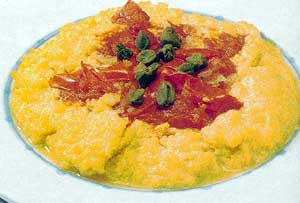Santorini's local products
What makes Santorini’s local products unique?
As a result the land of Santorini offers:
- Capers
- Cucumber
- Fava ( yellow split peas)
- Grapes (wine varieties)
- Goat cheese (ch loro)
- Small tomatoes (cherry tomatoes growing up waterless)
- Figs
- One glove garlic
- Pistachio
- Water melon (small ones)
- White eggplant
- A great variety of herbs & spices…dill, mint, fennel, basil, saffron, oregano, thyme, rosemary, marjoram, sage
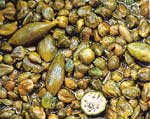

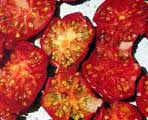
Capers
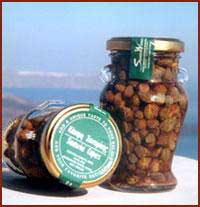
The capper flowers are the summer ‘roses’ of the Mediterranean. You can see them hanging from the southern crevices of the Caldera rock and from the white-washed walls of old Cycladic houses.
The ancient Greeks were familiar with the caper plant, and we have plenty of references in ancient texts where the authors comment on the merits and use of the plant’s buds. In antiquity capers were used as appetizers or as condiment. Zeno’s often quoted exclamation ‘by caper!’ shows the significance of this plant in antiquity. The Byzantine Paul of Aegina recommends a slice of bread topped with capers, vinegar and honey as an appetizer before each meal.
In modern times capers are basically used to spice a variety of dishes and sauces. This is mainly due to their very small size and particular taste. Collection of the caper buds should be done preferably in the months of May, June and July. The capers are collected when they are still the size of a small bean and placed in fresh water for 10 days. To turn the capers sweeter, the water needs to be changed often. Subsequently, the capers are placed in a solution of vinegar and salt and sealed in air-tight glass jars. Picled capers are good for 10 days. This mode of preserving caper buds (and leaves) is common around the Mediterranean basin. The same is true as regards the use of capers as a pungent supplement to various salads (e.g. tomato or even cabbage). The caper buds and leaves are unique, offering a piquant taste and freshness even when dried. They find extensive use in the local cuisine of Santorini. Capers marry well with and add a pleasing colour and taste to chickpeas puree, tomato salads, and chick-peas balls.
Split peas puree: Fava, yellow and rare
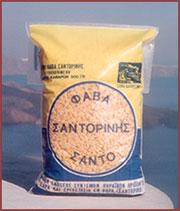
The term originates from the Latin Favus, meaning fava beans. The ancient Greeks produced a wholesome meal out of the dry fava beans.
The split-peas of Santorini are famous all over Greece. This is not only owing delicious taste when pureed, but also because they cook fast, relative to other varieties. The split-peas of Santorini are more like green peas (albeit golden-yellow in colour), which in the old days were reduced to powder in hand mills. The split-peas of Santorini constitute a basic intergradient for other dishes.
The yellow puree that results from the boiling of split-peas marries well with tomato sauce, capers, onions, meat, octopus and such herbs as mint and parsley. The split-peas of Santorini are rather expensive, and this id because of their advantage in cooking, excellent taste and flexibility in a variety of recipes.Local production amounts to 4-5 tonnes annually.
